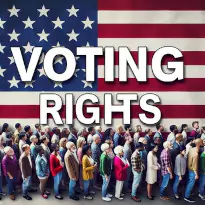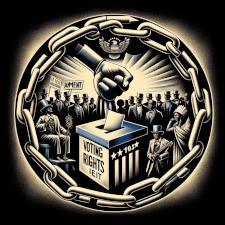Voter suppression has a long history
Voter suppression has a long history, tracing back to colonial times when many groups, including women, Native Americans, and African Americans, were barred from voting. The struggle for voting rights has been ongoing, with significant milestones like the Civil Rights Act of 1964. Along with the Voting Rights Act of 1965, which aimed to eliminate discriminatory practices like literacy tests and poll taxes.
However, new forms of suppression have emerged over time. But before we look at the Civil Rights Act of 1964 and the Voting Rights Act of 1965 we must get some history and context of voting in the United States which was limited to White Men only for a very long time.
What is The Civil Rights Act of 1964
Is a landmark piece of racial U.S. legislation that outlawed major forms of discrimination against racial, ethnic, national, and religious minorities, and women. It ended unequal application of voter registration requirements and racial segregation in schools, the workplace, and facilities that served the general public (“public accommodations”).
The Act was signed into law by President Lyndon B. Johnson on July 2, 1964, and it was a major triumph of the civil rights movement. Title VII of the Act prohibited discrimination by employers on the basis of race, color, religion, sex, or national origin, marking a significant step towards gender and racial equality. The Civil Rights Act of 1964 laid the foundation for future anti-discrimination legislation and had a profound impact on American society, contributing to the gradual dismantling of institutionalized segregation and discrimination.
What is The Voting Rights Act of 1965
Is a landmark piece of federal legislation in the United States that aimed to overcome legal barriers at the state and local levels that prevented African Americans from exercising their right to vote as guaranteed under the 15th Amendment to the U.S. Constitution.
Signed into law by President Lyndon B. Johnson on August 6, 1965, the Act prohibited racial discrimination in voting. It was particularly significant for removing obstacles such as literacy tests, poll taxes, and other practices that had been used to disenfranchise racial minorities.
A key provision of the Act was its “preclearance” requirement, which required jurisdictions with histories of discriminatory voting practices to receive federal approval before changing their election laws. This Act dramatically increased voter registration in the minority electorate, fundamentally changing the American political landscape by ensuring more comprehensive and equitable voter representation.
Table of Contents
- Voting: Historical Context and Evolution
- Voting Rights Shift in Political Dynamics:
- The 15th Amendment
- The 19th Amendment
- The Supreme Court case Nixon v. Condon
- The 1930s
- A Long Fight for Equality
- Civil Rights Act of 1964:
- Voting Rights Act of 1965:
- Voting Rights Act Amendments of 1970:
- Voting Rights Act Amendments of 1975:
- Voting Rights Act Amendments of 1982:
- National Voter Registration Act of 1993 (Motor Voter Act):
- Help America Vote Act of 2002 (HAVA):
- Voting Rights Act Reauthorization and Amendments Act of 2006:
- Following the 2020 U.S. elections
- 154 Years Since The 15th Amendment
Voting: Historical Context and Evolution

Post-Reconstruction Challenges:
After the collapse of Reconstruction in 1877, African American men, who had been granted the right to vote through the 15th Amendment in 1870, faced increasing disenfranchisement in the former Confederate states.
This was due to a resurgence of white supremacist policies and the implementation of laws that undermined their voting rights, such as poll taxes, literacy tests, intimidation, and fraud.
The infamous “grandfather clause” also played a significant role in disenfranchising African American men by restricting voting rights to those who had the right to vote before 1867—a period when African Americans were not allowed to vote.
Voting Rights Shift in Political Dynamics:
The 1930s also witnessed significant political shifts and challenges. The Supreme Court case Nixon v. Condon in 1932 struck down a Texas law that allowed political parties to choose who could vote in their primary elections, a decision that had implications for voting rights.
Continued Struggle for Equal Voting Rights:
Despite the passage of key amendments and acts, the struggle for equal voting rights continued, particularly for minority groups. The landscape of voting rights in the 1930s was characterized by a mix of progress and setbacks, reflecting the ongoing battle for equality and fair representation in the American democratic process.
This period set the stage for the later civil rights movement and the subsequent Voting Rights Act of 1965, which sought to address and rectify many of the discriminatory practices that had been prevalent.
The 15th Amendment

Ratified in 1870, was a significant milestone in American history, particularly in the context of voting rights. Here’s an overview:
- Core Purpose: The 15th Amendment was primarily designed to grant African American men the right to vote. It states: “The right of citizens of the United States to vote shall not be denied or abridged by the United States or by any state on account of race, color, or previous condition of servitude.
- Historical Context: The amendment was part of the Reconstruction era reforms following the Civil War. It aimed to address the inequalities and disenfranchisement faced by former slaves and to rebuild the American political landscape on a more equitable foundation.
- Challenges and Limitations: Despite its ratification, the 15th Amendment faced significant challenges in its implementation. Many Southern states enacted Jim Crow laws, including literacy tests, poll taxes, and grandfather clauses, effectively circumventing the amendment and continuing to prevent African Americans from voting.
- Legacy and Impact: The 15th Amendment laid the groundwork for future civil rights legislation, including the Civil Rights Act of 1964 and the Voting Rights Act of 1965. These acts sought to enforce the principles set out in the 15th Amendment and to eliminate the various discriminatory practices that had been used to deny African Americans the right to vote.
- Continued Relevance: The amendment remains a cornerstone of voting rights discussions in the United States, particularly in the context of debates over voter ID laws, redistricting, and other voting-related issues.
The 19th Amendment
Voting Rights for Women and Native Americans:
Ratified in 1920, was a pivotal moment in the history of American democracy. It expanded voting rights to a significant portion of the population that had been excluded for much of the nation’s history. Here’s an overview:
Native Americans were granted citizenship and the right to vote through the Indian Citizenship Act in 1924, but some states continued to bar them from voting until much later.
- Core Content: The 19th Amendment states, “The right of citizens of the United States to vote shall not be denied or abridged by the United States or by any state on account of sex.” This effectively granted women the right to vote.
- Historical Background: The push for women’s suffrage in the United States began in earnest in the mid-19th century. Key events, such as the Seneca Falls Convention in 1848, marked the formal start of the women’s suffrage movement. Prominent suffragists like Elizabeth Cady Stanton, Susan B. Anthony, and Lucretia Mott played pivotal roles in advocating for women’s rights, including the right to vote.
- Challenges and Struggles: The journey to the amendment’s ratification was marked by considerable activism, protests, and legal battles. Women suffragists faced significant opposition and societal challenges. The movement was intertwined with other reform movements of the era, including the temperance and abolitionist movements.
- Impact and Limitations: While the 19th Amendment was a groundbreaking achievement in terms of gender equality, its impact was initially limited for many women, particularly women of color, who continued to face significant barriers to voting due to racial discrimination and laws like Jim Crow in the South.
- Legacy: The 19th Amendment has had a lasting impact on American politics and society. It laid the groundwork for subsequent movements and legal actions aimed at achieving true equality in voting rights, regardless of gender or race.
The ratification of the 19th Amendment represented a major step towards inclusivity in American democracy, highlighting the ongoing struggle for equality and the importance of civic activism in effecting societal change.
The Supreme Court case Nixon v. Condon
Decided in 1932, is a notable case in the history of voting rights in the United States. Here’s a summary of the case and its significance:
- Background: The case revolved around the Texas Democratic Party’s practice of excluding African Americans from participating in its primary elections. Dr. Lawrence A. Nixon, an African American physician and a registered voter in El Paso, Texas, was denied the right to vote in the Democratic primary due to his race, despite paying his poll tax.
- Legal Issue: The central legal question was whether the Texas Democratic Party’s rules that barred African Americans from participating in primary elections violated the 14th and 15th Amendments of the U.S. Constitution. The 14th Amendment guarantees equal protection under the law, and the 15th Amendment prohibits denying the right to vote based on race.
- Supreme Court Decision: The Supreme Court ruled in favor of Nixon. The Court held that the Texas Democratic Party’s rules were unconstitutional as they violated the 15th Amendment. This decision was significant because, at the time, the Democratic Party primary was effectively the only meaningful electoral contest in the South, and excluding African Americans from these primaries was a method of disenfranchisement.
- Impact: Nixon v. Condon was a critical step in the fight against racially discriminatory voting practices. It challenged the system of “white primaries,” which were a major barrier to African American political participation in the South. However, it didn’t end the practice entirely, as subsequent legal and legislative actions continued to be necessary.
- Continued Relevance: The case is an important part of the legal history leading up to the Civil Rights Movement and the eventual passage of the Voting Rights Act of 1965. It highlights the role of the judiciary in addressing racially discriminatory practices in the electoral process.
Nixon v. Condon is an example of how legal challenges have been used to confront and dismantle systemic barriers to voting in the United States.
The 1930s
The United States was marked by continued struggles for equal voting rights, especially for African Americans and other marginalized groups. Despite the passage of the 15th and 19th Amendments, various barriers and discriminatory practices remained in place:
- Persistence of Jim Crow Laws: In the Southern states, Jim Crow laws continued to enforce racial segregation and prevent African Americans from voting. These laws included poll taxes, literacy tests, and other measures designed to circumvent the 15th Amendment’s provisions.
- White Primaries: The practice of “white primaries” was still prevalent, where political parties, particularly in the South, held primary elections that were only open to white voters. These primaries effectively excluded African Americans from the political process, as the primary winners were almost assured of victory in the general elections due to the one-party dominance in these regions.
- Legal Challenges and Supreme Court Decisions: Cases like Nixon v. Condon in 1932 challenged the legality of racially exclusive voting practices. The Supreme Court’s decision in this case marked a significant step against the practice of white primaries, though it did not completely eradicate them.
- Civil Rights Organizations and Advocacy: Civil rights organizations, including the NAACP, played a crucial role in the fight for voting rights, often providing legal assistance in challenging discriminatory practices and advocating for federal laws to protect voting rights.
- Economic and Social Intimidation: Beyond legal barriers, African Americans and other minorities often faced economic reprisals, threats, and violence when they attempted to exercise their right to vote. This social and economic intimidation was a significant deterrent to political participation.
The 1930s were a period of both setbacks and progress in the long struggle for equal voting rights in the United States. The challenges of this era laid the groundwork for the more widespread civil rights movements and legislative victories of the 1950s and 1960s.
The struggle for voting rights in the United States during the 1940s and 1950s continued to evolve, marked by significant challenges and gradual progress, particularly for African Americans and other marginalized groups.
The 1940s
- World War II Impact: The involvement of the United States in World War II played a crucial role in changing attitudes towards civil rights. African Americans, along with other minority groups, participated in the war effort, both on the battlefield and on the home front, which contributed to a growing demand for civil rights and an end to racial discrimination.
- Legal Strides: There were important legal developments, including court cases that challenged racial discrimination. For example, in Smith v. Allwright (1944), the U.S. Supreme Court ruled that white primaries were unconstitutional, striking a significant blow against one of the key instruments of voter suppression in the South.
- NAACP’s Role: The National Association for the Advancement of Colored People (NAACP) continued to be instrumental in challenging segregation and discrimination, using legal avenues to fight for civil rights.
The 1950s
- The Civil Rights Movement: The 1950s saw the emergence of the Civil Rights Movement as a major force in American politics and society. This movement, led by figures like Martin Luther King Jr., Rosa Parks, and other civil rights activists, began to challenge segregation and discrimination more directly and visibly.
- Brown v. Board of Education (1954): This landmark Supreme Court decision declared state laws establishing separate public schools for black and white students to be unconstitutional, setting a precedent for further legal challenges to racial discrimination.
- Continued Voter Suppression: Despite these advancements, African Americans in the South still faced significant barriers to voting, including literacy tests, poll taxes, and other discriminatory practices, as well as threats and violence.
- Montgomery Bus Boycott (1955-1956): This significant event in the Civil Rights Movement, initiated by Rosa Parks’ refusal to give up her seat on a segregated bus, highlighted the broader struggle for equality, including voting rights.
The 1940s and 1950s set the stage for the major legislative victories of the 1960s, particularly the Civil Rights Act of 1964 and the Voting Rights Act of 1965. These decades were a period of building tensions, increasing activism, and crucial legal battles that would shape the future of civil rights in America.
A Long Fight for Equality
We have to step back for a minute to just appreciate how long it took to get there to now.
The journey from the ratification of the 15th Amendment in 1870 to the enactment of the Voting Rights Act (VRA) of 1965 spans 95 years. This near-century was marked by significant struggles, legal battles, and social movements aimed at securing and enforcing the right to vote for all American citizens, regardless of race or color.
The 15th Amendment, which constitutionally guaranteed African American men the right to vote, faced numerous challenges in its enforcement, particularly in the form of Jim Crow laws, literacy tests, poll taxes, and other discriminatory practices that were prevalent, especially in the Southern states.
The long and arduous path towards true electoral equality and fairness reached a pivotal moment with the passage of the Voting Rights Act in 1965, which aimed to overcome legal barriers at state and local levels that prevented African Americans from exercising their right to vote.
This landmark legislation represented a culmination of the civil rights movement’s efforts and a significant step forward in the United States’ ongoing journey towards a more inclusive democracy.
Civil Rights Act of 1964:
This landmark piece of legislation was a pivotal step in the fight against racial discrimination in the United States. It aimed to end segregation in public places and banned employment discrimination based on race, color, religion, sex, or national origin. While it wasn’t focused exclusively on voting rights, it set the stage for broader civil rights reforms, including those specifically targeting voting rights.
Voting Rights Act of 1965:
This Act is one of the most significant pieces of civil rights legislation in U.S. history. It was specifically designed to overcome legal barriers at the state and local levels that prevented African Americans from exercising their right to vote as guaranteed under the 15th Amendment to the U.S. Constitution. Key provisions of this act included the elimination of literacy tests as a prerequisite to voting, and the implementation of federal oversight in areas with a history of discriminatory voting practices.
These two acts collectively represented a major shift in the legal landscape of the United States, particularly in terms of voting rights and civil liberties. They marked significant steps forward in the effort to ensure fair and equal access to the voting booth for all Americans, particularly for African American communities who had faced systemic obstacles in exercising their right to vote.
Following the Voting Rights Act (VRA) of 1965, several significant federal acts were passed to further enhance and protect voting rights in the United States. Here are some key pieces of legislation:
Voting Rights Act Amendments of 1970:
This act extended the special provisions of the VRA, which were initially set to expire after five years. It also made voting easier for residents in jurisdictions that had a literacy test by providing for federal examiners to register voters.
Voting Rights Act Amendments of 1975:
These amendments expanded the scope of the VRA to protect language minorities, including Hispanic, Asian, Alaskan Native, and American Indian voters. This included providing bilingual election materials in areas with significant populations of citizens who spoke languages other than English.
Voting Rights Act Amendments of 1982:
This extension made it easier to challenge discriminatory voting practices by allowing plaintiffs to prove the effects of such practices rather than proving discriminatory intent. It extended the special provisions of the VRA for another 25 years.
National Voter Registration Act of 1993 (Motor Voter Act):
This act was designed to increase voter registration and streamline the process. It required states to offer voter registration opportunities at the same time as a driver’s license application or renewal and at public assistance and disability offices.
Help America Vote Act of 2002 (HAVA):
In response to the issues observed in the 2000 presidential election, HAVA was enacted to address problems with voting systems and voter access. It provided funds to states to upgrade their voting equipment and established the Election Assistance Commission to help administer federal election laws.
Voting Rights Act Reauthorization and Amendments Act of 2006:
This act reauthorized the expiring provisions of the VRA, including the preclearance requirements, for another 25 years. It was passed to continue the protections against discriminatory voting practices.
These acts reflect the ongoing efforts to ensure fair and equal access to voting in the United States and to address emerging challenges in the administration of elections.
Following the 2020 U.S. elections
There was a notable trend in various states to enact legislation that many viewed as an effort to suppress voting. This period witnessed a wave of new laws and regulations, with some states introducing measures that made it more challenging to vote.
These measures included stricter voter identification requirements, limitations on mail-in voting, reductions in the number of polling places, shortened early voting periods, and constraints on voter registration processes. Critics argued that these changes disproportionately affected minority groups, the elderly, and people with disabilities, potentially impacting their ability to participate in the electoral process.
Proponents of these measures often cited election security and integrity as the primary reasons for the changes. The wave of legislative efforts to alter voting processes and requirements sparked significant debate and legal challenges, reflecting the ongoing tension in American democracy over voting rights and access.
154 Years Since The 15th Amendment
As of 2024, it has been 154 years since the ratification of the 15th Amendment in 1870. This Amendment was a landmark change in the United States Constitution, granting African American men the right to vote and marking a significant step in the nation’s journey towards equal voting rights for all its citizens and we’re still fighting the same fight 154 years later.

